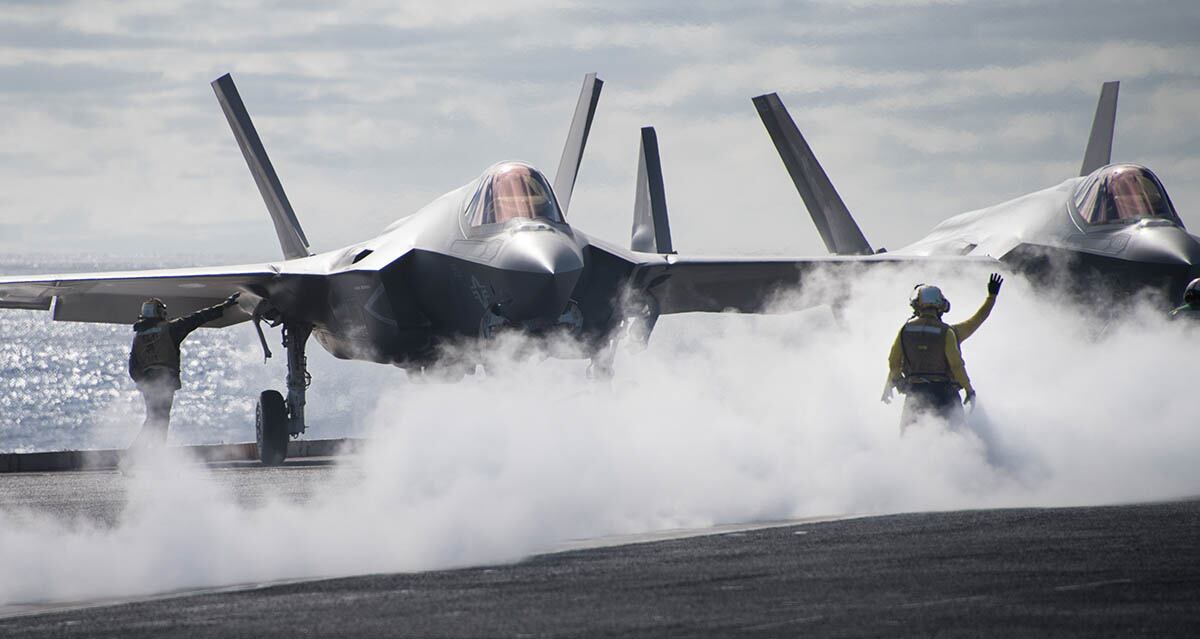The Navy’s F-35C, the carrier variant of the Lightning II Joint Strike Fighter, has reached Initial Operating Capability, service leaders told Navy Times on Thursday.
The good news about the Navy’s stealthy jet program came two months after officials declared the F-35Cs flown by the Argonauts of Strike Fighter Squadron 147 became qualified for carrier landings and launches and had been deemed safe for flight.
The IOC declaration indicates that the squadron in on track to deploy on board the aircraft carrier Carl Vinson in 2021. The Argonauts reached the milestone by having 10 F-35Cs in the squadron, with the requisite spare parts, support equipment, tools, technical publications as well as training and logistics programs to support them.
“We’re very proud of what our Sailors have accomplished in the Joint Strike Fighter community,” said Capt. Max McCoy, commander of the Joint Strike Fighter Wing, in a Thursday statement emailed to Navy Times. “We will continue to learn and improve ways to maintain and sustain F-35C as we prepare for first deployment.”
On the last day of the month, the IOC announcement also fulfilled a Navy promise that the squadron would achieve IOC status in February.
“The F-35C is ready for operations, ready for combat and ready to win,” said Vice Adm. DeWolfe “Bullet” Miller III — the Navy’s “Air Boss” who commands Naval Air Forces — in the statement. “We are adding an incredible weapon system into the arsenal of our carrier strike groups that significantly enhances the capability of the joint force.”
RELATED

Although the Navy should become the first service to take the carrier variant of the Joint Strike Fighter to sea, the Marine Corps also plans to field four F-35C squadrons.
The Marines achieved IOC for their F-35B vertical take-off and landing fighter in 2015 and have flown them on combat missions from the amphibious assault ship Essex.
Once acquired, the Marine F-35Cs will be assigned to carrier air wings for overseas deployments, officials say.
Until then, the focus of the F-35C program remains on California’s San Joaquin Valley and Naval Air Station Lemoore there.
That Navy base has been prepping for this moment for five years and is slated to become the home to the first seven F-35C squadrons, plus a training squadron.
In 2017, the Navy reactivated the Rough Raiders of Strike Fighter Squadron 125 to be the Navy’s fleet replacement squadron for the F-35C.
It played a key role in helping VFA-147 transition to the Joint Strike Fighter and officials said on Thursday it’s going to be where Marine Corps F-35C squadrons get their fleet replacement aviators, too.
That’s why Lemoore has erected new structures and remodeled others to support Joint Strike Fighter operations, maintenance and training, including a Pilot Fit Facility, Centralized Engine Repair Facility, Pilot Training Center and a newly-remodeled hangar, officials said.
The Navy has yet to announce when the next F/A-18 squadron will begin their transition to the F-35C.
Mark D. Faram is a former reporter for Navy Times. He was a senior writer covering personnel, cultural and historical issues. A nine-year active duty Navy veteran, Faram served from 1978 to 1987 as a Navy Diver and photographer.




